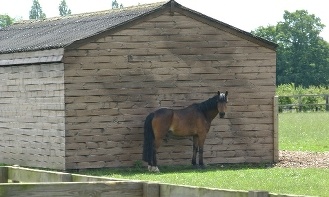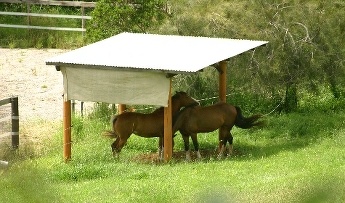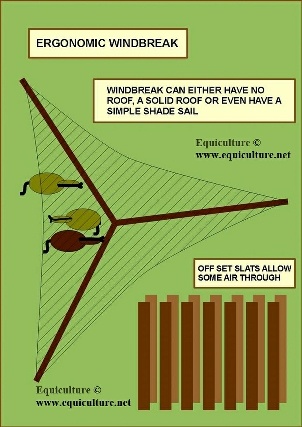How ESSENTIAL is shade/shelter for a horse?
Feb 12, 2021
Horses spend a significant amount of their time utilising shade/shelter. It is essential to them, yet it is common to see horses with access to neither. A domestic horse should have constant access to shade/shelter.

Horses spend a significant amount of their time utilising shade/shelter.
A free-living (wild or feral horse) can and does seek these out when necessary, but a domestic horse can only make the best of what is provided for them by their owner. Therefore you must provide these essential facilities for any horses in your care.
How important is shade for horses in hot weather?
When it is hot, a horse should always be able to get out of the sun. Horses that do not have access to shade will become stressed if they are not able to find it when they need it.

When it is hot, a horse should always be able to get out of the sun.
There are several reasons why shade is essential for horses when it is hot:
Horses overheat very easily
The larger body an animal has, the longer it takes to cool down. So, small animals heat up/cool down much more quickly than large animals. Therefore, do not judge the temperature on how you feel when it is hot because your horse feels even hotter.
What horses eat keeps them warm
The high-fibre diet of a horse (hay/grass) gives off lots of heat while being digested. This is good in cold weather but works against them in hot weather. Often a horse will not eat if it is too warm for this reason.
Areas of white skin on horses burn easily
Horses with white (pink) skin burn very quickly in the sun, particularly white facial markings over the nostrils, white leg markings, etc.
Horse flies and other pest insects are often worse in the full sun
Pests prefer full sun. Therefore, a horse without shade may also be plagued by pests. A well-ventilated shelter with a breeze flowing through it will keep out many annoying insects.
The eyes of horses have evolved to let in lots of light
This is so that they can make the best use of any available light at dawn and dusk. Horses can be uncomfortable in very bright weather (especially if they do not have an adequate forelock). Many breeds of domestic horses do not have much forelock.
Some breeds of horses are susceptible to eye cancers
Breeds such as Clydesdales and Appaloosas have more unpigmented skin around the eyes, making them more at risk.
Are rugs and hoods good enough for horses if there is no shade?
A horse needs to be able to get out of the sun to a cooler area. Horse rugs (such as cotton or cotton/mesh) should not be used as a substitute for shade. Fine meshed rugs are suitable for horses allergic to certain insect bites, but they still need shade access.
How can you learn more about horses, land management and the environment?
Start by signing up for the free mini-course about Horses, pasture and grazing www.equiculture.net/equiculture-free-mini-course
Do horses need shelter during cold, wet and windy weather?
A healthy horse can cope with low (dry) temperatures without any problem, but when it is windy and raining, a horse will usually seek shelter. Some breeds have been bred to have fine skin and coat (such as Thoroughbreds and Standardbreds), which means that they tend to feel the wet and cold more than tougher, hardier breeds of horses (although there are exceptions, therefore, treat every horse as an individual). Even horses with thick winter coats need somewhere to escape from strong wind and rain.
What is natural shelter and shade for horses?
Vegetation, such as trees/bushes etc. in paddocks, is a natural shelter and provides a wildlife habitat - some of which perform beneficial functions such as eating flying pest insects by the thousands! This vegetation needs to be protected from horses (at least until it is mature). Horses will eat the leaves, chew the bark and compact the soil around the roots if given free access.
What is 'man-made' shelter and shade for horses
Manufactured paddock shelters must be large enough for the entire herd to get into without danger of less dominant herd members getting trapped. Consider building one large shade/shelter (rather than a smaller one in each paddock) that all horses can get to daily. This can be situated in an area linked by laneways to the various paddocks, which means the shade/shelter can be used all year round. Paddocks can then be rested and rotated, which is vital for good land management (the idea of having one area that the horses bring themselves to is the basis of The Equicentral System – www.equiculture.net/the-equicentral-system

Manufactured shelters in paddocks must be large enough for the entire herd to get into without danger of less dominant members of the herd getting trapped.

This is the previous shelter as a plan.
Traditional stables tend to be too hot for shade in hot weather (due to the enclosed sides) and should have a shaded yard attached to which the horse can get out. Many horse properties already have buildings and surfaced areas that can be utilised for this purpose; it is sometimes just a matter of ‘thinking outside the square’. Stables can be adapted into walk-in walk-out shelters, for example.
Shelters can take various forms, from a simple roof with no sides, which gives some protection against the elements but most importantly provides shade without being too enclosed (a ‘bus stop’ shelter), to a roof with one, two or three sides (four would make it a stable), to a wall with no roof (a windbreak commonly seen in temperate climates).
Vegetation can be planted to act as a windbreak but allows cool breezes to pass through in summer. If you plant vegetation for this purpose, you can use shade cloth on the sides of the building as a temporary ‘windbreak’ and for shade until the foliage has matured sufficiently. Combining a manufactured shelter (such as a large roof with no sides) with trees/bushes positioned to reduce wind speed works best in many cases.
If horses are kept in individual paddocks with a shelter in each, they should be positioned so that the horses can see and touch each other while using it. Otherwise, they will tend to ignore the shade/shelter because the need to be near other horses often overrides the need to seek protection. In this situation, it is preferable to create a shelter that covers part of several yards/paddocks. That way, horses can stand together and receive the benefits of the shade/shelter. In this situation, it is essential to have safe fencing between each yard to minimise the risk of fence injuries caused by horses interacting over a fence.
Tips for providing shade and shelter for horses
-
Locate shelters on a firm footing - i.e. avoid slopes, clay or low-lying areas that get wet.
-
Build shelters with a non-erodible surface (e.g. concrete, compacted quarry rubble, or commercial horse rubber flooring on a base), and fit gutters to control/divert rain/stormwater.
-
If dust or mud is an issue, surface high traffic areas around the shade/shelter with materials such as fine quarry rubble, sand etc. to stabilise the soil (if using sand, be aware that you will need another surface in the area that you provide feed to avoid sand colic).
-
In some cases, consider building a movable shelter; if the location is incorrect, you can move it later.
-
With groups of horses, hay can be fed in a shade/shelter, but it must be large enough to get out of each other’s way safely. In the case of an individual shelter, aim to feed the horse in the shelter to keep feed dry and to encourage maximum impact (time spent by the horse in one spot) to be concentrated on a durable surface. Never feed concentrates to a group of horses in a confined area as concentrated feeding increases competition.
We have a book about the subject of equine buildings/facilities (and The Equicentral System); you can have a look at it here: www.equiculture.net/the-equicentral-system-books
If you enjoyed this article, check out the others on the blog. Also, make sure you sign up for the free mini-course called Horses, Pasture and Grazing and the free 23-page PDF called 10 common POSITION and BALANCE checks for riders


















